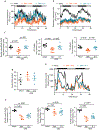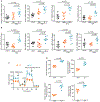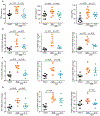Preclinical efficacy of the GPER-selective agonist G-1 in mouse models of obesity and diabetes
- PMID: 31996464
- PMCID: PMC7083206
- DOI: 10.1126/scitranslmed.aau5956
Preclinical efficacy of the GPER-selective agonist G-1 in mouse models of obesity and diabetes
Erratum in
-
Erratum for the Research Article "Preclinical efficacy of the GPER-selective agonist G-1 in mouse models of obesity and diabetes" by G. Sharma et al.Sci Transl Med. 2022 May 25;14(646):eadc9803. doi: 10.1126/scitranslmed.adc9803. Epub 2022 May 25. Sci Transl Med. 2022. PMID: 35613283 No abstract available.
Abstract
Human obesity has become a global health epidemic, with few safe and effective pharmacological therapies currently available. The systemic loss of ovarian estradiol (E2) in women after menopause greatly increases the risk of obesity and metabolic dysfunction, revealing the critical role of E2 in this setting. The salutary effects of E2 are traditionally attributed to the classical estrogen receptors ERα and ERβ, with the contribution of the G protein-coupled estrogen receptor (GPER) still largely unknown. Here, we used ovariectomy- and diet-induced obesity (DIO) mouse models to evaluate the preclinical activity of GPER-selective small-molecule agonist G-1 (also called Tespria) against obesity and metabolic dysfunction. G-1 treatment of ovariectomized female mice (a model of postmenopausal obesity) reduced body weight and improved glucose homeostasis without changes in food intake, fuel source usage, or locomotor activity. G-1-treated female mice also exhibited increased energy expenditure, lower body fat content, and reduced fasting cholesterol, glucose, insulin, and inflammatory markers but did not display feminizing effects on the uterus (imbibition) or beneficial effects on bone health. G-1 treatment of DIO male mice did not elicit weight loss but prevented further weight gain and improved glucose tolerance, indicating that G-1 improved glucose homeostasis independently of its antiobesity effects. However, in ovariectomized DIO female mice, G-1 continued to elicit weight loss, reflecting possible sex differences in the mechanisms of G-1 action. In conclusion, this work demonstrates that GPER-selective agonism is a viable therapeutic approach against obesity, diabetes, and associated metabolic abnormalities in multiple preclinical male and female models.
Copyright © 2020 The Authors, some rights reserved; exclusive licensee American Association for the Advancement of Science. No claim to original U.S. Government Works.
Conflict of interest statement
Figures








References
-
- Chevalier N, Fenichel P, Bisphenol A: Targeting metabolic tissues, Rev Endocr Metab Disord 16, 299–309 (2015). - PubMed
-
- Saunders KH, Umashanker D, Igel LI, Kumar RB, Aronne LJ, Obesity pharmacotherapy, Med Clin North Am 102, 135–148 (2018). - PubMed
-
- Kolonin MG, Saha PK, Chan L, Pasqualini R, Arap W, Reversal of obesity by targeted ablation of adipose tissue, Nat Med 10, 625–632 (2004). - PubMed
MeSH terms
Substances
Grants and funding
LinkOut - more resources
Full Text Sources
Medical

